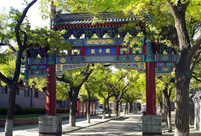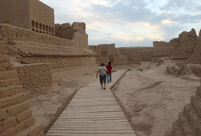 Global ambassadors of ecotourism gather in Nanjing
Global ambassadors of ecotourism gather in Nanjing
 Taiwan woman marries into Kazak family, 100 sheep plus a flat as dowry
Taiwan woman marries into Kazak family, 100 sheep plus a flat as dowry
 College girls take graduation photos under water in Chongqing
College girls take graduation photos under water in Chongqing
 Cartoon: Xi and football
Cartoon: Xi and football
 Chinese influence sweeps ROK
Chinese influence sweeps ROK
 Post-90s beauty boxer grapples four men
Post-90s beauty boxer grapples four men
 3,000-year-old tea town through lenses
3,000-year-old tea town through lenses
 22 archaeological sites along Silk Road in China
22 archaeological sites along Silk Road in China
 Football babies, Samba dancers embrace 'World Cup'
Football babies, Samba dancers embrace 'World Cup'
 Beautiful scenery along China’s Grand Canal
Beautiful scenery along China’s Grand Canal
Further negotiations on issues including geopolitics, technological standards and funding are needed for a high-speed railway China is planning between the Xinjiang Uygur autonomous region and Eastern Europe, according to experts.
The 6,000-km link will start in Xinjiang and pass through Kyrgyzstan, Tajikistan, Uzbekistan, Turkmenistan, Iran and Turkey to Bulgaria, said Zhao Xiaogang, former chairman of China South Locomotive and Rolling Stock Co (CSR), a leading Chinese industrial manufacturer and exporter.
Zhao is also an adviser to the China Institute for Innovation and Development Strategy.
Passenger train speeds will reach 200 kph and freight trains 160 kph, Zhao told China Daily.
Investment in the line will be about $150 billion, Zhao said, adding that it could be largely finished in 2020 and fully completed by 2030.
"It can be regarded as a new Silk Road," he said.
The pace of railway construction in Xinjiang has increased significantly since September, when President Xi Jinping raised the idea of a Silk Road economic belt. He proposed reviving the ancient trade route connecting China, Central Asia and Europe.
Zhao also said China is considering a 3,000-km line from Yunnan province that would pass through Laos, Thailand and Malaysia to Singapore.
Total investment would be about $75 billion and the project would boost the GDP of China and related countries by $375 billion. The project could be largely finished in 2020 and fully completed in 2025, he said.
Premier Li Keqiang has also promoted high-speed railway technology during his many overseas visits.
During a visit to the CSR Zhuzhou Electric Locomotive Co in Hunan province on Friday, Li asked workers to ensure the quality of Chinese high-speed railways and to safeguard the reputation of equipment made in China.
"Every time I visit a foreign country, I introduce your products to its government leaders. I hope to see more of your products in future overseas trips," he said.
Ji Jialun, a railway expert at Beijing Jiaotong University, said many details are still under discussion concerning the high-speed railway planned between Xinjiang and Europe.
"A host of factors, such as geopolitics, technological issues and funding have to be considered," he said. "As far as I know, the government has begun to negotiate this project with Kazakhstan, which is willing to cooperate with us on building such a link."
China has the technological and engineering capability to link its rail network with those of its western neighbors, but negotiations still have to be held over the new line's track gauge, Ji said.
"Central Asian and Middle Eastern nations use 1,524 mm broad gauge tracks, while China adopts the standard gauge of 1,435 mm," Ji said.
"China Railway Corp hopes to persuade those countries to adopt the standard gauge for this line, otherwise train wheels will have to be changed at borders."
Zhao Lei contributed to this story.
 Featured hutongs in Beijing
Featured hutongs in Beijing Separate college entrance exam
Separate college entrance exam Flash mob dance
Flash mob dance Picturesque scenery of Ghost City
Picturesque scenery of Ghost City Children attend First Writing Ceremony
Children attend First Writing Ceremony Female master poses for graduation photos with son
Female master poses for graduation photos with son Silk Road, China's Grand Canal listed as World Heritage Sites
Silk Road, China's Grand Canal listed as World Heritage Sites PKU students imitate famous paintings in real-person photos
PKU students imitate famous paintings in real-person photos Chinese 'Slumdog Millionaire'
Chinese 'Slumdog Millionaire' Islands in S. China Sea better shown on new vertical atlas of China
Islands in S. China Sea better shown on new vertical atlas of China Girl takes father’s portrait to travel the world
Girl takes father’s portrait to travel the world Images of Xi'an: Part one
Images of Xi'an: Part one In Pictures: Female fans of World Cup
In Pictures: Female fans of World Cup Top 20 hottest women in the world in 2014
Top 20 hottest women in the world in 2014  China's top 10 representative architectures
China's top 10 representative architecturesDay|Week|Month